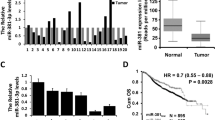Abstract
Epithelial–mesenchymal transition (EMT) is a crucial step in epithelial cancer invasion and metastasis. miR-153 has been identified as a key EMT suppressor. Accordingly, this study aimed to determine the possible relation of miR-153 downregulation to EMT through MTDH modulation. The miR-153 and MTDH expression profiles of human breast cancer specimen were determined by qPCR and evaluated by correlation analysis. Cell viability and clonogenic assays were applied to explore the impact of miR-153 on suppression of proliferation and oncogenic potential of breast cancer cells. Cell migration and invasion assays were used for the functional analysis of miR-153 in MCF-7 and MDA-MB-231 cells. Luciferase assay was adopted to identify MTDH as a new direct target of miR-153. Ectopic expression of miR-153 could significantly inhibit tumor growth and impair the migration and invasion of breast cancer cells. Overexpression of miR-153 simultaneously increased E-cadherin, decreased vimentin expression, and downmodulated EMT-associated transcription factors. miR-153 was negatively correlated with MTDH in cell lines and clinical samples. Overexpression of miR-153 significantly suppressed MTDH, as demonstrated by in vitro MTDH 3′-untranslated region luciferase report assay. MTDH is a direct downstream target of miR-153 and is involved in the miR-153-induced suppression of the migration and invasion of breast cancer cells. Our findings indicate that miR-153 functions as a tumor suppressor and miR-153/MTDH link is a promising therapeutic target for breast cancer.






Similar content being viewed by others
References
Creighton CJ, Gibbons DL, Kurie JM (2013) The role of epithelial–mesenchymal transition programming in invasion and metastasis: a clinical perspective. Cancer Manag Res 5:187–195
Brabletz T (2012) To differentiate or not–routes towards metastasis. Nat Rev Cancer 12(6):425–436
Zhang B, Liu XX, He JR, Zhou CX, Guo M, He M, Li MF, Chen GQ, Zhao Q (2011) Pathologically decreased miR-26a antagonizes apoptosis and facilitates carcinogenesis by targeting MTDH and EZH2 in breast cancer. Carcinogenesis 32(1):2–9
Xia X, Du R, Zhao L, Sun W, Wang X (2014) Expression of AEG-1 and microvessel density correlates with metastasis and prognosis of oral squamous cell carcinoma. Hum Pathol 45(4):858–865
Lee SG, Su ZZ, Emdad L, Sarkar D, Franke TF, Fisher PB (2008) Astrocyte elevated gene-1 activates cell survival pathways through PI3K-Akt signaling. Oncogene 27(8):1114–1121
Yoo BK, Emdad L, Su ZZ, Villanueva A, Chiang DY, Mukhopadhyay ND, Mills AS, Waxman S, Fisher RA, Llovet JM et al (2009) Astrocyte elevated gene-1 regulates hepatocellular carcinoma development and progression. J Clin Investig 119(3):465–477
Di Leva G, Croce CM (2013) The role of microRNAs in the tumorigenesis of ovarian cancer. Front Oncol 3:153
Korpal M, Ell BJ, Buffa FM, Ibrahim T, Blanco MA, Celia-Terrassa T, Mercatali L, Khan Z, Goodarzi H, Hua Y et al (2011) Direct targeting of Sec23a by miR-200s influences cancer cell secretome and promotes metastatic colonization. Nat Med 17(9):1101–1108
Xu Q, Sun Q, Zhang J, Yu J, Chen W, Zhang Z (2013) Downregulation of miR-153 contributes to epithelial–mesenchymal transition and tumor metastasis in human epithelial cancer. Carcinogenesis 34(3):539–549
Dong R, Liu X, Zhang Q, Jiang Z, Li Y, Wei Y, Yang Q, Liu J, Wei JJ, Shao C et al (2014) miR-145 inhibits tumor growth and metastasis by targeting metadherin in high-grade serous ovarian carcinoma. Oncotarget 5(21):10816–10829
Tang Y, Liu X, Su B, Zhang Z, Zeng X, Lei Y, Shan J, Wu Y, Tang H, Su Q (2014) microRNA-22 acts as a metastasis suppressor by targeting metadherin in gastric cancer. Mol Med Rep 11(1):454–460
Hu G, Chong RA, Yang Q, Wei Y, Blanco MA, Li F, Reiss M, Au JL, Haffty BG, Kang Y (2009) MTDH activation by 8q22 genomic gain promotes chemoresistance and metastasis of poor-prognosis breast cancer. Cancer Cell 15(1):9–20
Heckman KL, Pease LR (2007) Gene splicing and mutagenesis by PCR-driven overlap extension. Nat Protoc 2(4):924–932
Bullock MD, Sayan AE, Packham GK, Mirnezami AH (2012) MicroRNAs: critical regulators of epithelial to mesenchymal (EMT) and mesenchymal to epithelial transition (MET) in cancer progression. Biology of the cell/under the auspices of the European Cell Biology Organization 104(1):3–12
Gregory PA, Bracken CP, Bert AG, Goodall GJ (2008) MicroRNAs as regulators of epithelial–mesenchymal transition. Cell Cycle 7(20):3112–3118
Mongroo PS, Rustgi AK (2010) The role of the miR-200 family in epithelial–mesenchymal transition. Cancer Biol Ther 10(3):219–222
Peter ME (2009) Let-7 and miR-200 microRNAs: guardians against pluripotency and cancer progression. Cell Cycle 8(6):843–852
Zhang N, Wang X, Huo Q, Sun M, Cai C, Liu Z, Hu G, Yang Q (2014) MicroRNA-30a suppresses breast tumor growth and metastasis by targeting metadherin. Oncogene 33(24):3119–3128
Kim TH, Kim YK, Kwon Y, Heo JH, Kang H, Kim G, An HJ (2010) Deregulation of miR-519a, 153, and 485-5p and its clinicopathological relevance in ovarian epithelial tumours. Histopathology 57(5):734–743
Xu J, Liao X, Wong C (2010) Downregulations of B-cell lymphoma 2 and myeloid cell leukemia sequence 1 by microRNA 153 induce apoptosis in a glioblastoma cell line DBTRG-05MG. Int J Cancer 126(4):1029–1035
Nohata N, Hanazawa T, Kikkawa N, Mutallip M, Sakurai D, Fujimura L, Kawakami K, Chiyomaru T, Yoshino H, Enokida H et al (2011) Tumor suppressive microRNA-375 regulates oncogene AEG-1/MTDH in head and neck squamous cell carcinoma (HNSCC). J Hum Genet 56(8):595–601
Acknowledgments
This study was supported by grants from National Nature Scientific Foundation of China (30901779, 81072068) and The Natural Science Foundation of Shandong Province (BS2011YY060, ZR2009CM047).
Conflict of interest
All authors of this paper have no financial and personal relationships with other people or organizations that could inappropriately influence this work.
Author information
Authors and Affiliations
Corresponding author
Rights and permissions
About this article
Cite this article
Li, W., Zhai, L., Zhao, C. et al. miR-153 inhibits epithelial–mesenchymal transition by targeting metadherin in human breast cancer. Breast Cancer Res Treat 150, 501–509 (2015). https://doi.org/10.1007/s10549-015-3346-y
Received:
Accepted:
Published:
Issue Date:
DOI: https://doi.org/10.1007/s10549-015-3346-y




